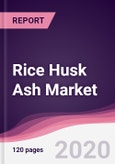Globally 482 million metric tons of husked rice is produced. Rice milling industries produce rice husk while milling of paddy. Complete burning of Rice husk produces rice husk ash which further utilized for different applications like power generation, fuel in boilers and so on. About 20 million tons of RHA is produced per annum. Most of the manufacturers of end use industries are providing innovative solutions in RHA market. Cement industries are the largest markets for RHA. North American countries are playing important role in RHA because of their demand in construction and steel industries.
Rice Husk Ash (RHA) Market Outlook
Although RHA is a waste produced from burning, it is widely used in different applications like Construction purpose, Power generation, insulating ladle in steel industry and so on industries. Cement and RHA are having pozzolanic properties. Due to similar properties, RHA is replacing some percentage of cement in construction industry. The special concrete mixes are formed and used as high performance concrete, high strength concrete, low permeability concrete for bridges, nuclear power plants and so on. In steel industry, it acts as insulator for ladles. This is also used for power generation. In rubber industry, tires are manufactured using RHA.
The price factors of RHA is cheap. It is almost 4-7 rupees per kilogram. Also it is available in different forms like granule, nodule and powder.
Rice Husk Ash Market Growth Drivers:
The cost effective nature of RHA driving force in this market. Use of RHA in concrete mixes reduces cement cost and increases the strength as well. For this, the use of RHA in construction industries is becoming common these days.
Rice Husk Ash Market challenges:
The ash produced from rice husk generates disposal problems and become constrain to the environment. To put a solution to this, RHA is used in different application for safe disposal. RHA is used in construction industries as concrete mixes. The demonstrated concrete can be recycled and reused for different application. Likewise this RHA is useful to the environment with reduced cost.
Rice Husk Ash Market
Rice Husk Ash Market Research Scope:
The base year of the study is 2017, with forecast done up to 2023. The study presents a thorough analysis of the competitive landscape, taking into account the market shares of the leading companies. It also provides information on unit shipments. These provide the key market participants with the necessary business intelligence and help them understand the future of the Rice Husk Ash. The assessment includes the forecast, an overview of the competitive structure, the market shares of the competitors, as well as the market trends, market demands, market drivers, market challenges, and product analysis. The market drivers and restraints have been assessed to fathom their impact over the forecast period. This report further identifies the key opportunities for growth while also detailing the key challenges and possible threats. The key areas of focus include the types of Rice Husk Ash Market, and their specific applications in different types of vehicles.
Rice Husk Ash Market Report: Industry Coverage:
Form of Rice Husk Ash: Granule, nodule, flake, Pellet, Powder.
Applications of Rice Husk Ash: Concrete Mixes like Green concrete, high performance concrete, Roofing Shingles, Building blocks, Insulators, Water proofing chemicals, Pesticides.
End Users of Rice Husk Ash: Construction Industry, Steel industry, Ceramics and Refractories, Silica Manufacturing, Rubber, Others.
Rice Husk Ash Market report also analyzes the major geographic regions for the market as well as the major countries for the market in these regions. The regions and countries covered in the study include:
- North America: The U.S., Canada, Mexico
- South America: Brazil, Venezuela, Argentina, Ecuador, Peru, Colombia, Costa Rica
- Europe: The U.K., Germany, Italy, France, The Netherlands, Belgium, Spain, Denmark
- APAC: China, Japan, Australia, South Korea, India, Taiwan, Malaysia, Hong Kong
- Middle East and Africa: Israel, South Africa, Saudi Arabia
Rice Husk Ash Market Key Players:
The key players referred in this market are Usher Agro ltd, KRBL ltd, Deelert, Astrra, Viet Delta Corp, Guru Metachem Pvt Ltd and 10 more companies.
Rice Husk Ash Market Trends and Market Research:
- Good year Tire and Rubber Company uses Rice husk ash to produce rubber tires. RHA became alternative source of silica to them to be used for manufacturing tires. Their innovation leads to environmental benefits without disposing RHA into land fill areas.
- The Recycling and management people are planning to design a cooker that utilizes natural rice husk as cooking gas. Also, the ash produced is used for concrete mixes, bricks, building materials and fertilizer production.
- The development of eco-friendly concrete using rice husk ash is also available in the market. Here to increase the strength of concrete the cost effective silica fumes are added. Use of RHA in concrete mixes also reduces the environmental pollution like land pollution and water pollution.
- The novel use of rice husk ash using silver nano particles as filter bed for purifying water in low income house-holds has been studied by Tata chemicals pvt ltd. This process removes arsenic and fluorine content to some extent.
Table of Contents
Methodology

LOADING...








